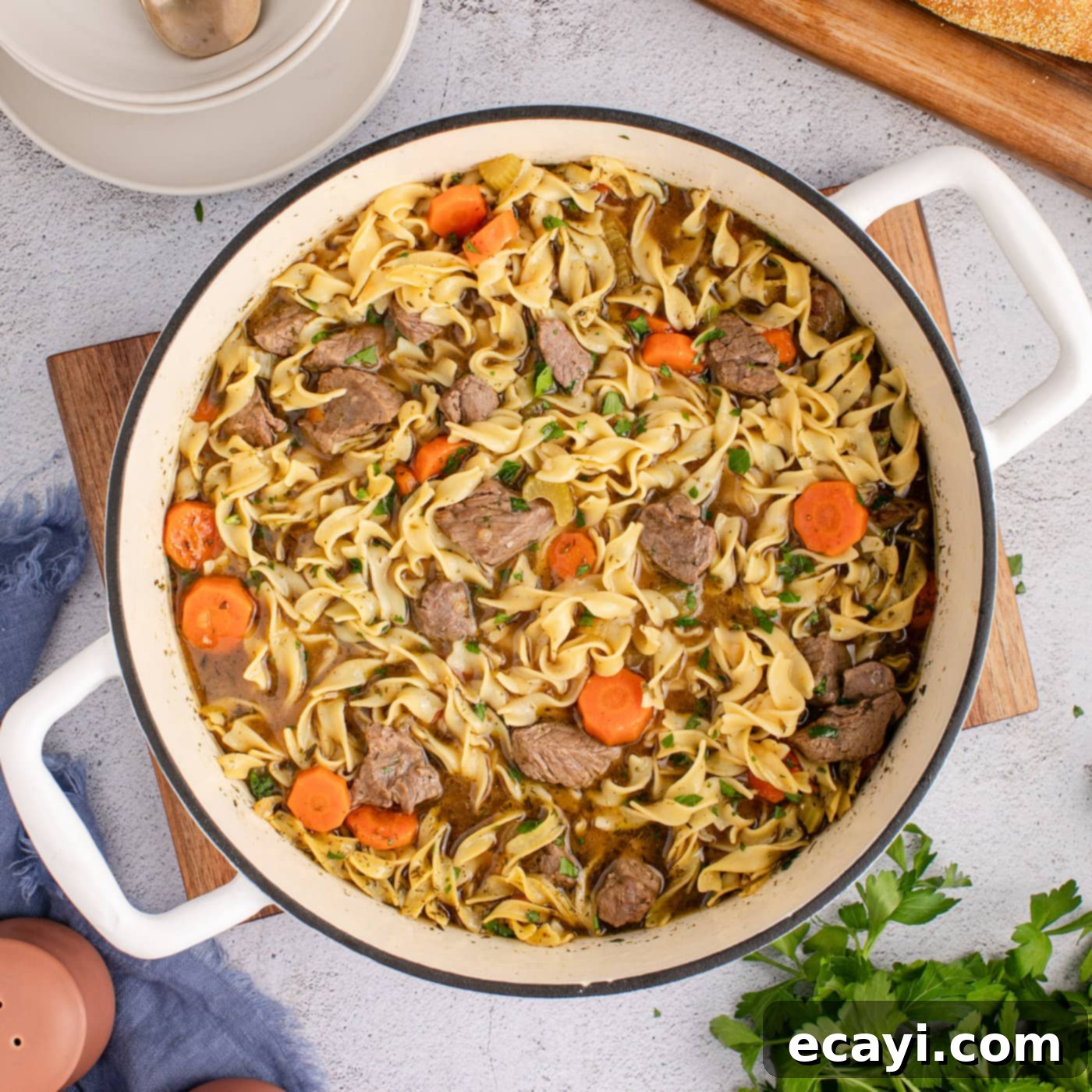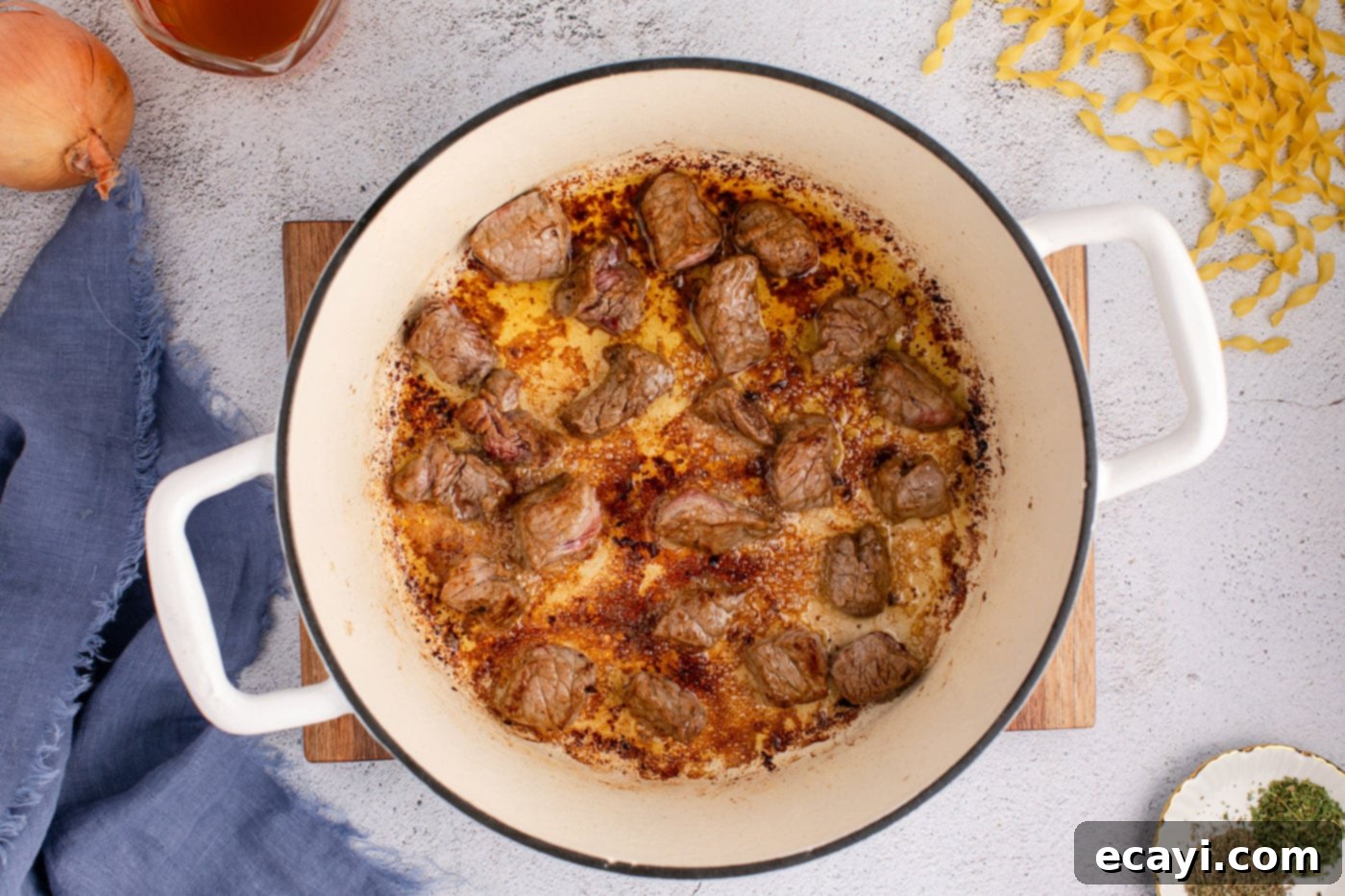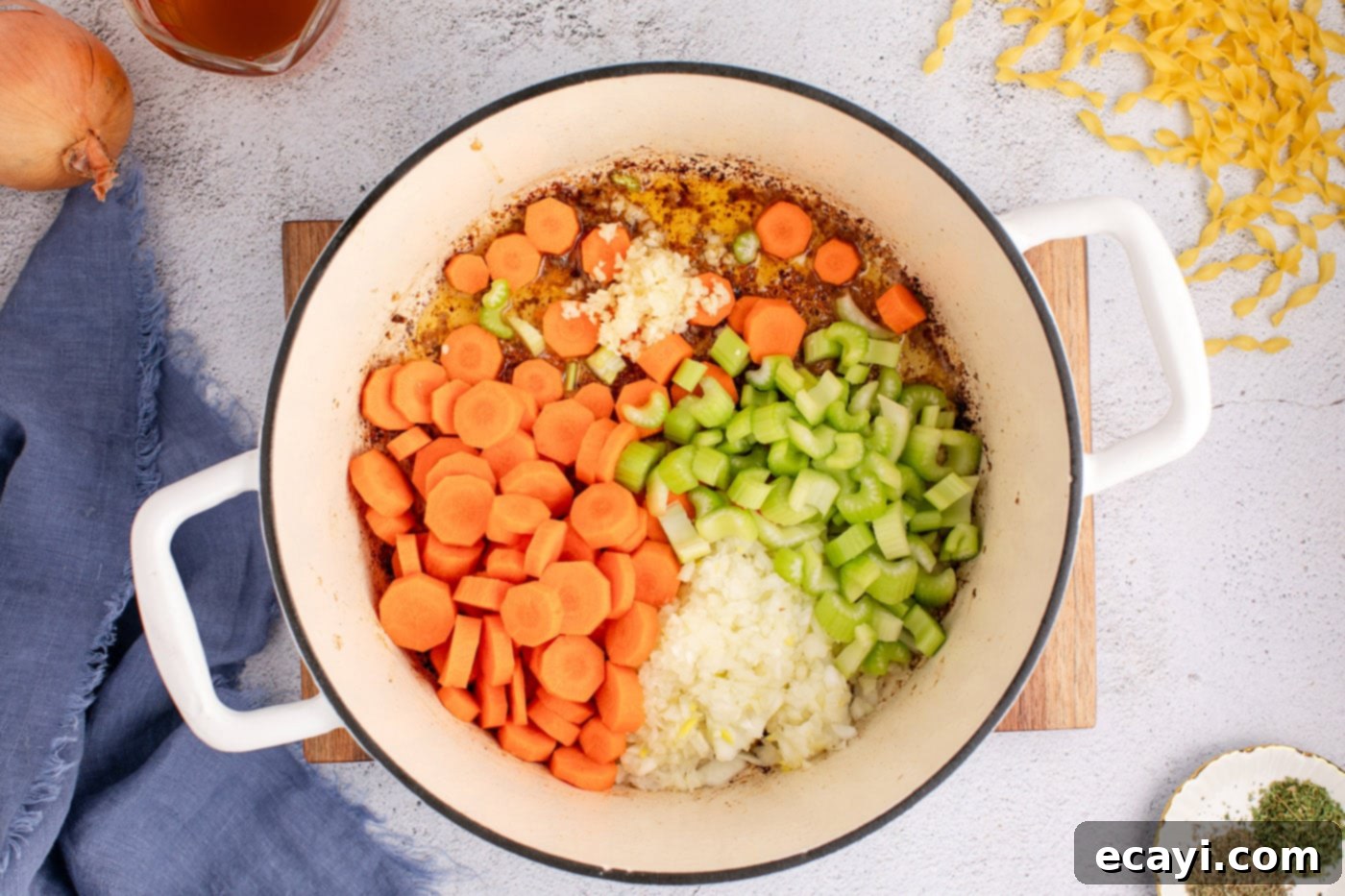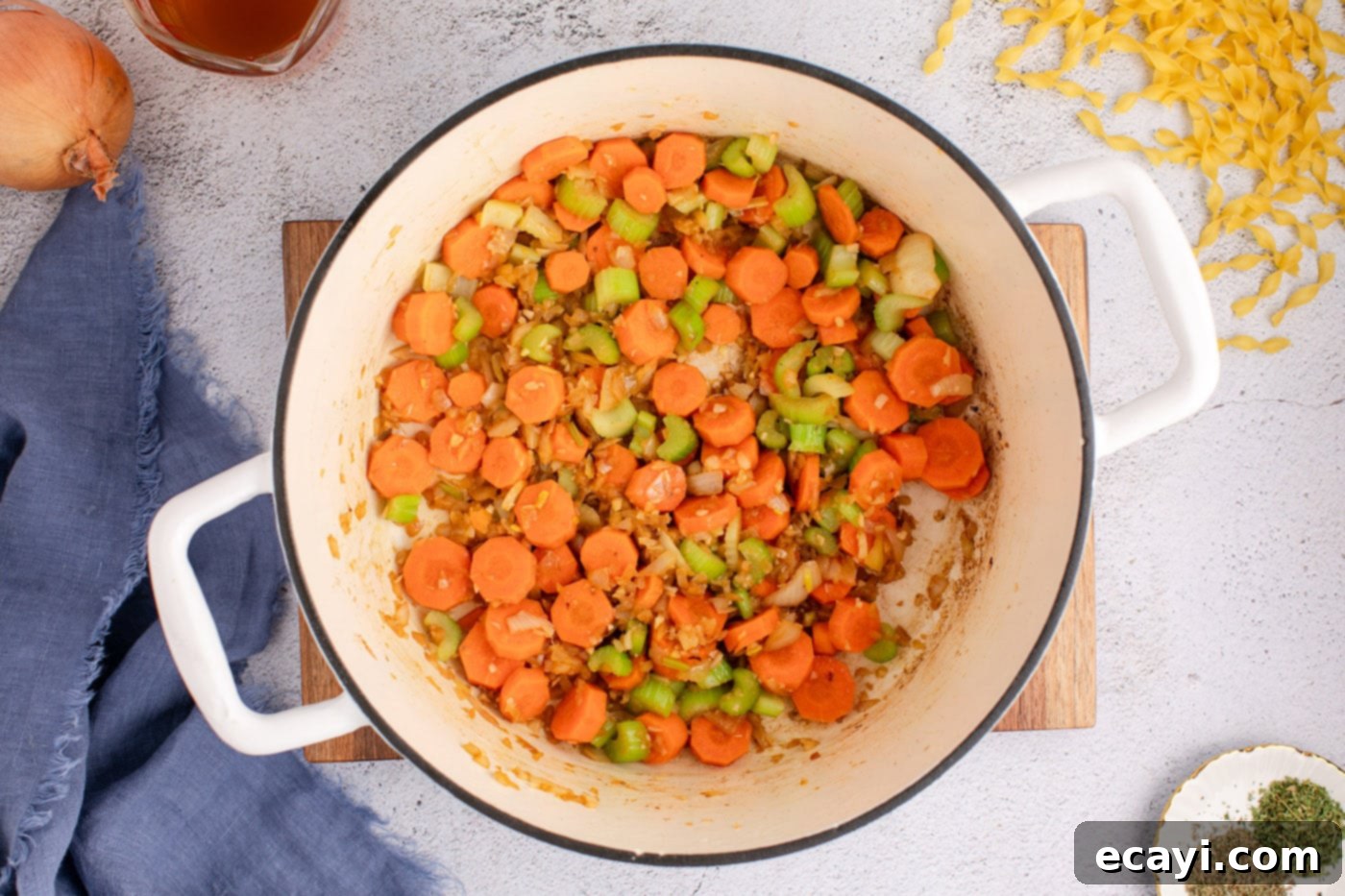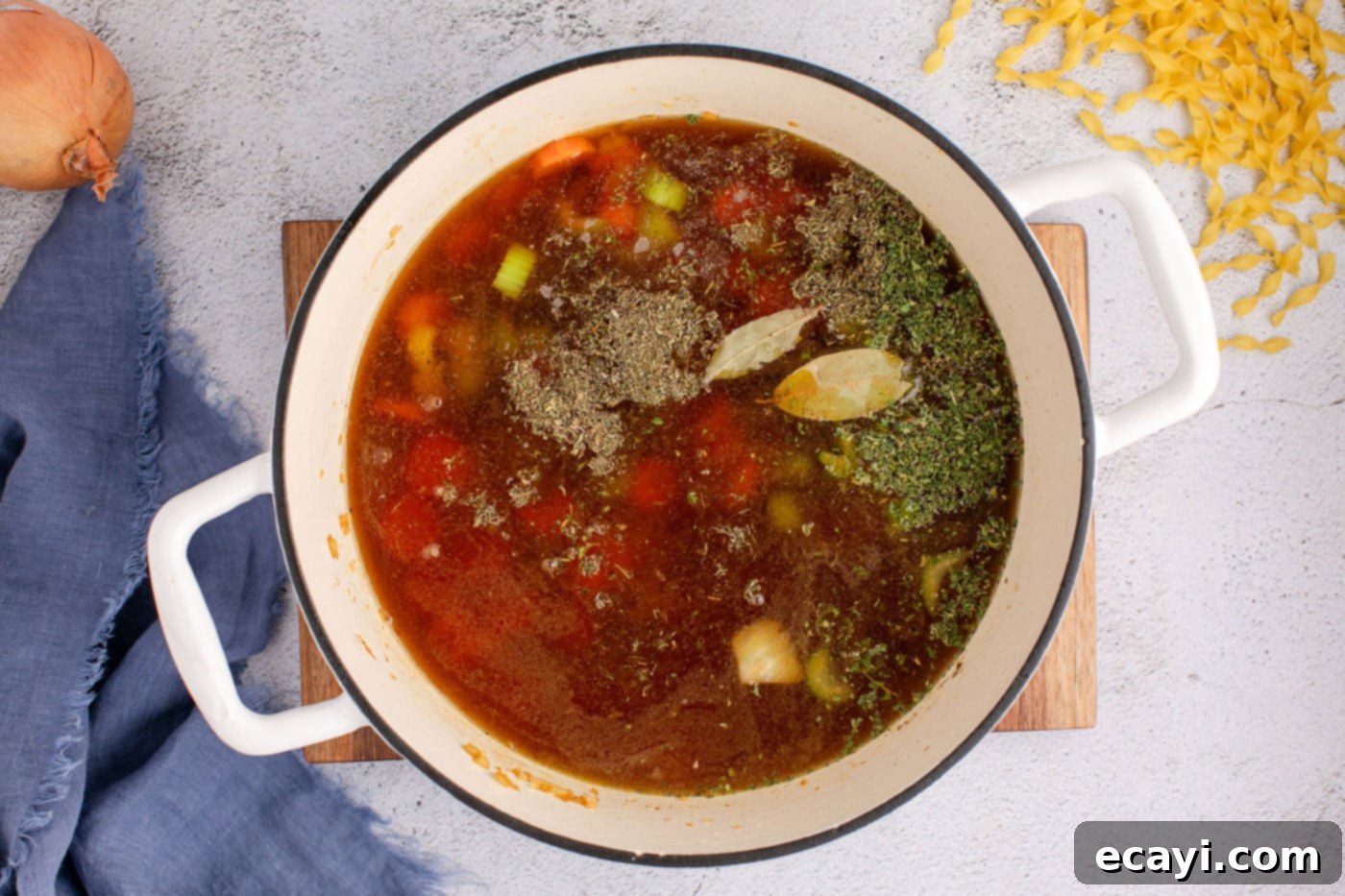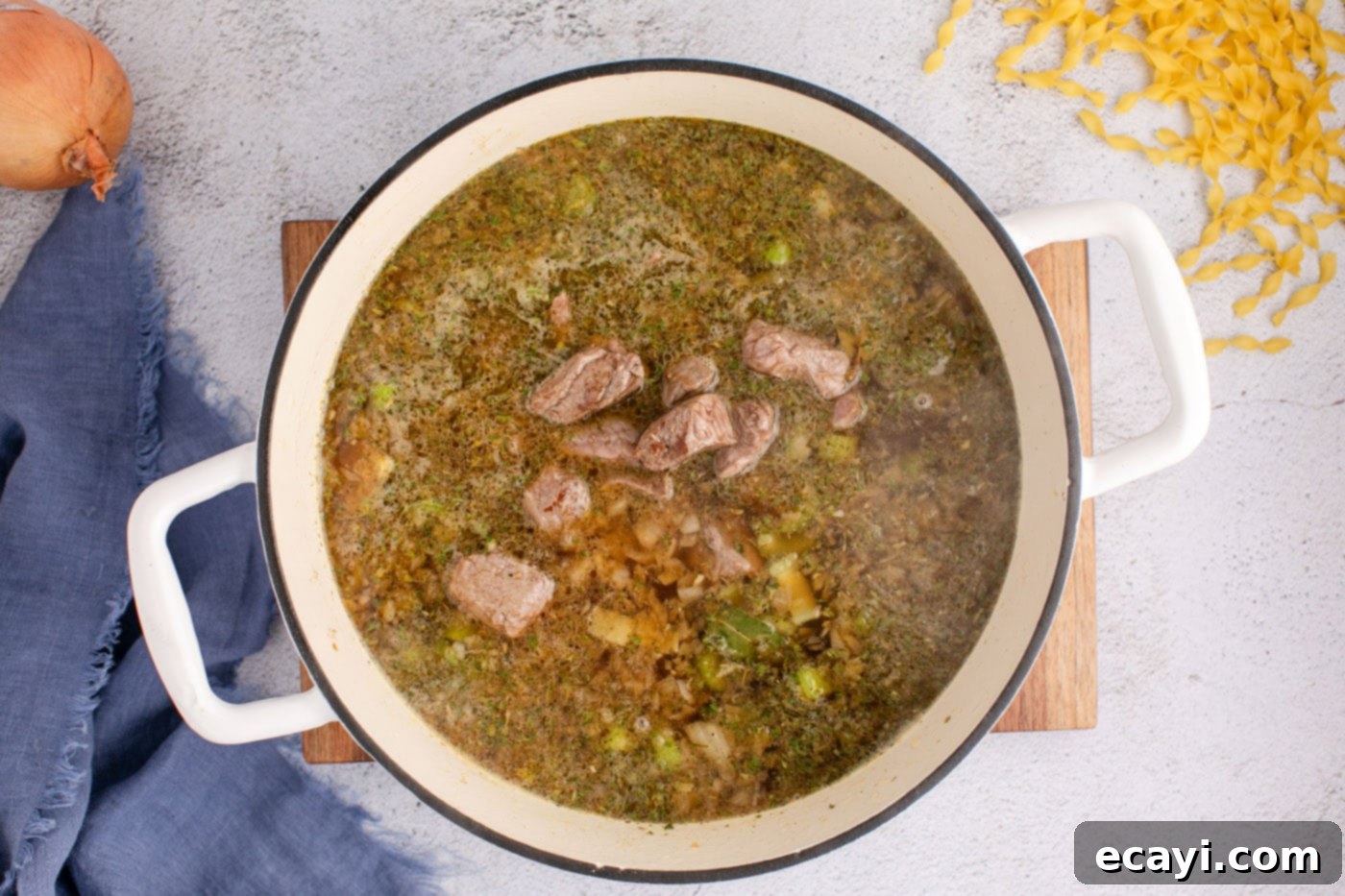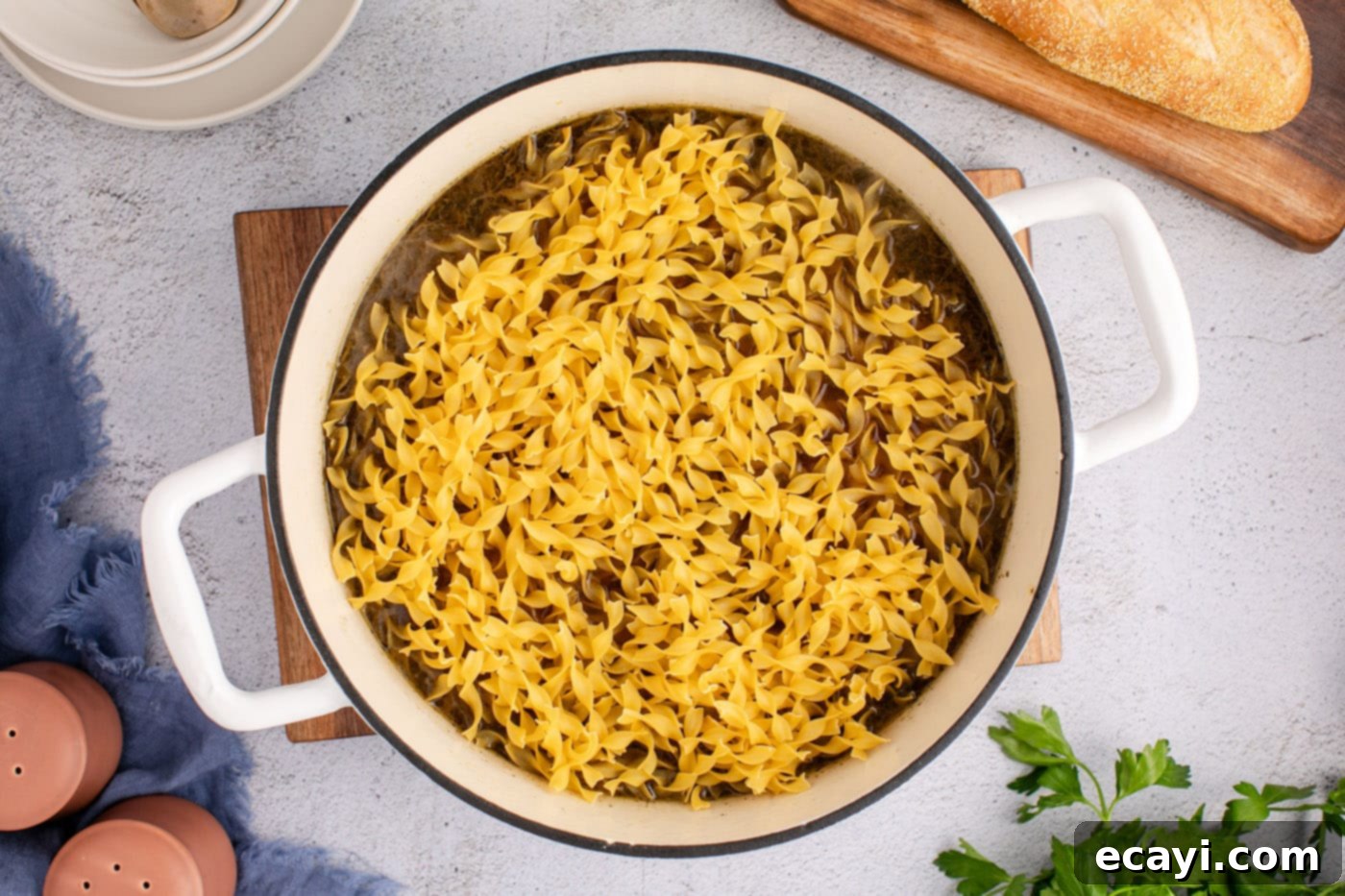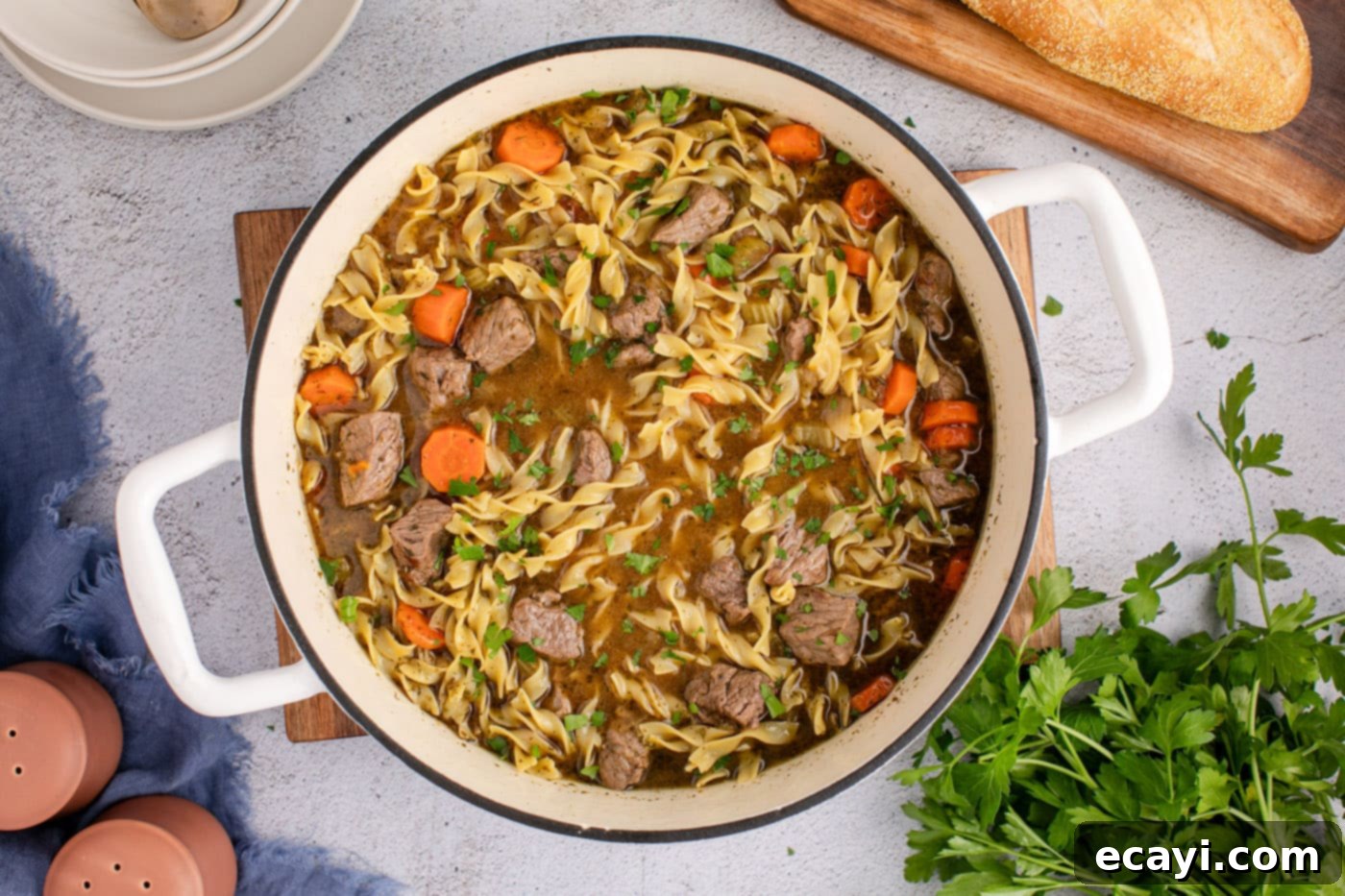Hearty & Easy Homemade Beef Noodle Soup: The Ultimate Comfort Food Recipe
There’s nothing quite as satisfying as a warm, comforting bowl of homemade soup, especially when it’s brimming with rich flavors and wholesome ingredients. This easy beef noodle soup recipe is the epitome of comfort food, designed to warm you from the inside out. It features succulent, tender chunks of beef, an abundance of fresh, vibrant vegetables, and perfectly cooked egg noodles, all simmered together in a deeply savory and aromatic broth. This robust soup is perfect for chilly evenings, a nourishing family meal, or simply when you’re craving something truly delicious and satisfying.
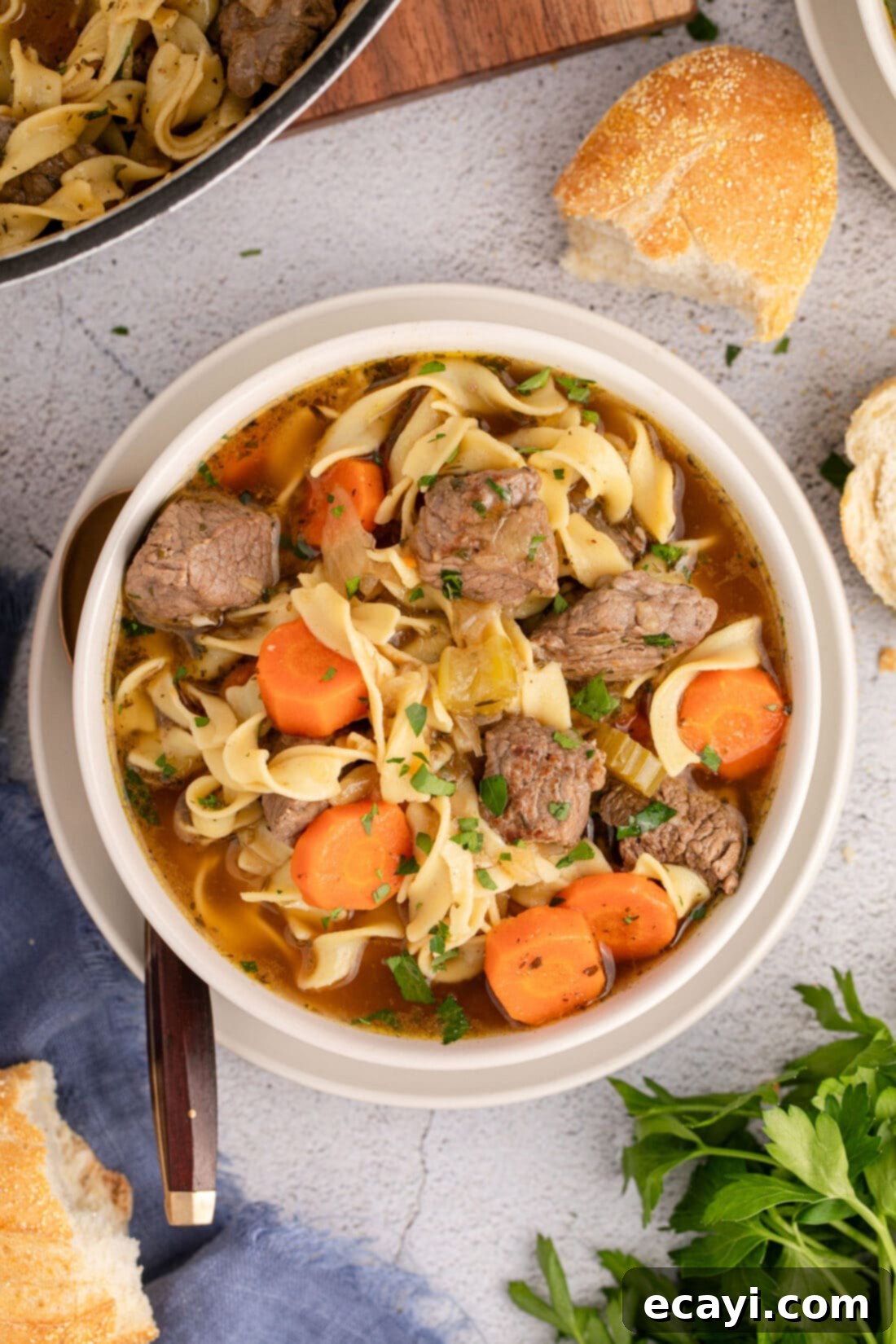
Why This Homemade Beef Noodle Soup Recipe Is a Must-Try
This beef noodle soup recipe truly delivers on flavor and ease, making it an ideal choice for busy weeknights or relaxed weekend cooking. At its core, it’s a celebration of classic comfort food – think tender, fall-apart beef stew meat, thick and chewy egg noodles, and a medley of aromatic vegetables like onion, carrots, celery, and garlic. These simple, hearty ingredients form the backbone of a soup that feels both incredibly nourishing and deeply satisfying.
What sets this recipe apart is its straightforward approach without compromising on taste. The preparation is remarkably simple: a quick chop of the fresh vegetables, a brief sear of the beef to lock in flavor, and then everything comes together in one pot. It’s a set-it-and-forget-it kind of meal, allowing the ingredients to slowly mingle and develop a rich, complex flavor profile as they simmer. The result is a wonderfully flavorful broth that ties all the elements together into a cohesive, delicious dish. It’s the ultimate antidote to a cold day, offering a soul-warming experience much like our favorite beef and noodles, but in a comforting soup form.
Beyond its delicious taste, this beef noodle soup offers fantastic nutritional value. It’s loaded with vitamins and fiber from the fresh vegetables, and protein from the beef, making it a balanced and wholesome meal. The long simmering process not only tenderizes the beef to perfection but also allows all the flavors to meld beautifully, creating a depth that store-bought soups can rarely achieve. You’ll love how effortlessly this recipe transforms basic ingredients into a culinary masterpiece that the whole family will adore.
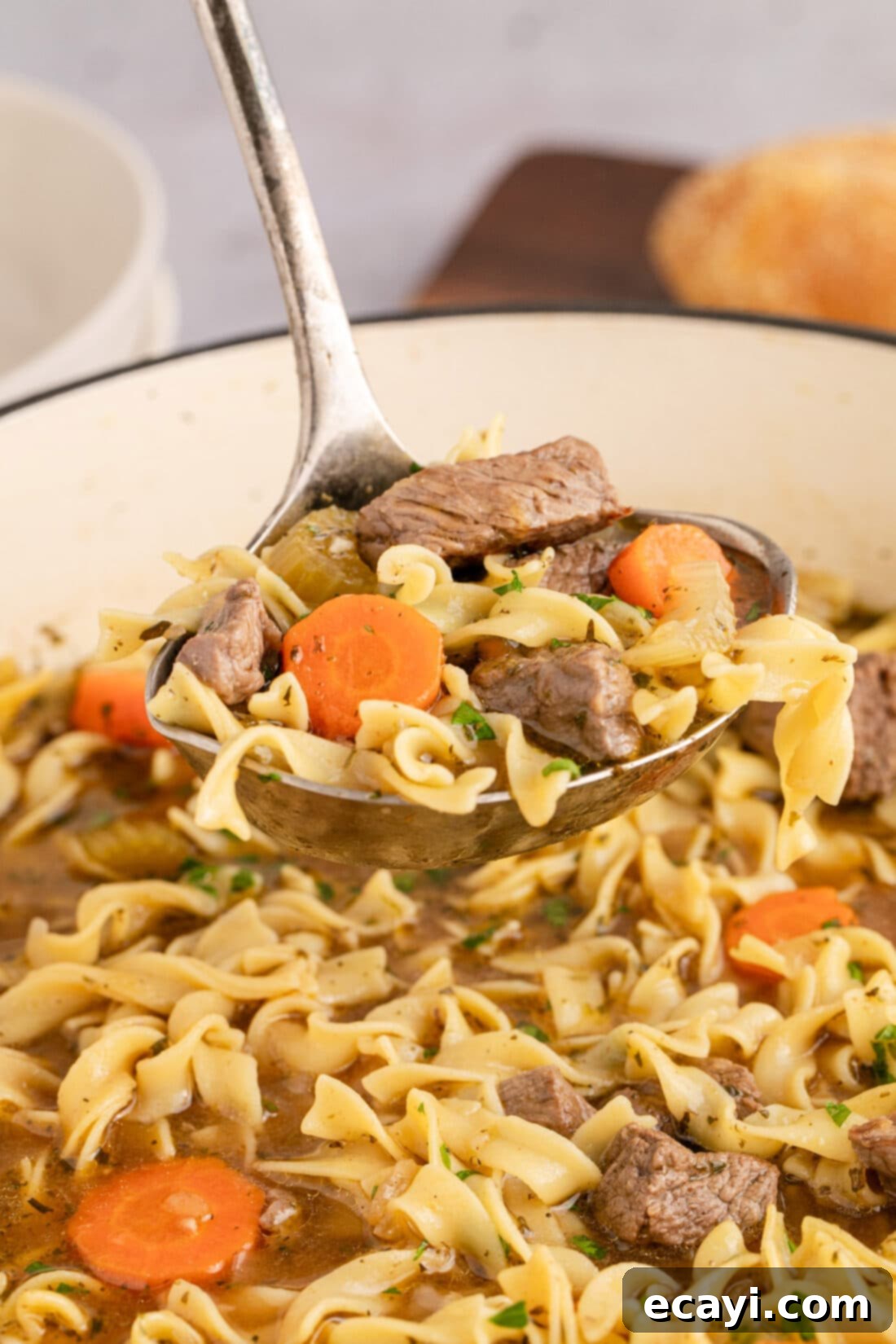
Essential Ingredients for Your Savory Beef Noodle Soup
Crafting this delicious beef noodle soup requires a thoughtful selection of fresh, high-quality ingredients. You’ll find all the precise measurements, detailed ingredients, and step-by-step instructions in the printable recipe card located at the conclusion of this comprehensive post. Gathering everything beforehand ensures a smooth and enjoyable cooking experience.
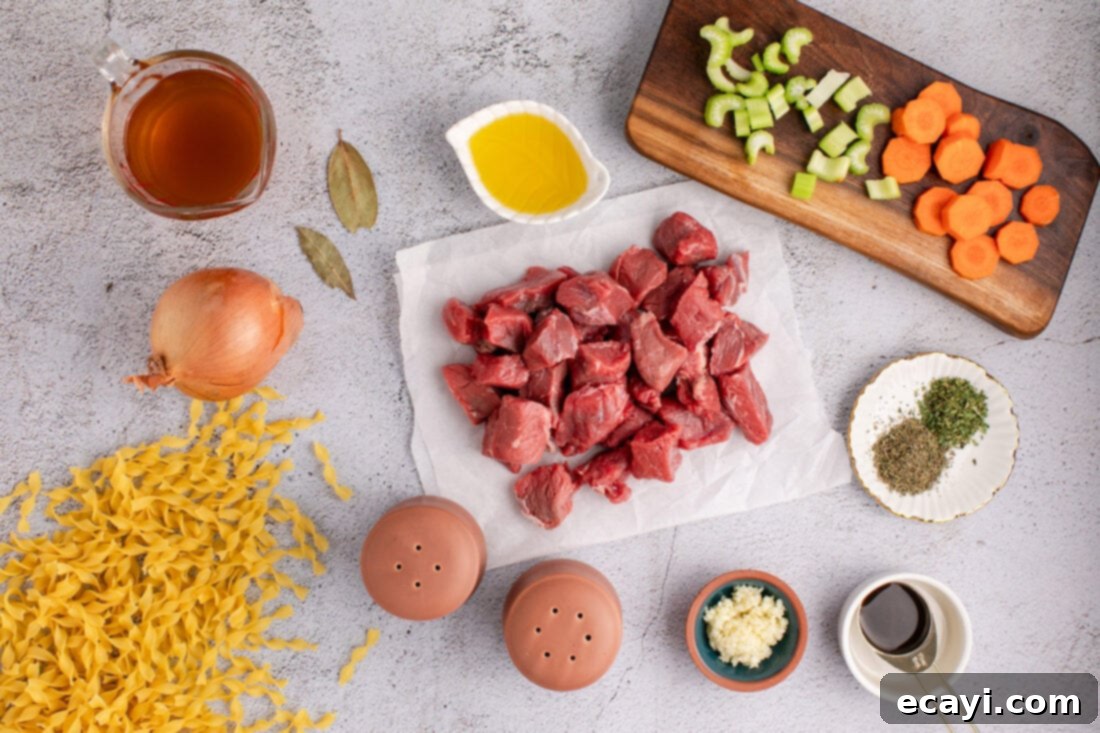
Detailed Ingredient Information and Smart Substitutions
Understanding each component of your beef noodle soup can elevate your cooking and allow for creative adaptations based on what you have on hand or dietary preferences. Here’s a closer look at the key ingredients:
BEEF – The star of this soup is undoubtedly the beef. We recommend using stewing beef, often labeled as beef stew meat, which typically comes from tougher cuts like chuck, round, or sirloin. These cuts are perfect for slow simmering because they contain collagen that breaks down over time, resulting in incredibly tender, flavorful meat. Look for pieces that are well-marbled for the best flavor and texture. If stewing beef isn’t available, you can also purchase a chuck roast and cut it into 1-inch cubes yourself. Avoid lean, quick-cooking cuts as they will become dry and tough with prolonged cooking.
NOODLES – The choice of noodles significantly impacts the soup’s texture and heartiness. For this recipe, we absolutely adore using thick egg noodles. Their substantial bite and ability to absorb the rich broth make them an ideal complement to the beef and vegetables. Other excellent choices include old-fashioned extra wide egg noodles or traditional Kluski noodles, which offer a similar satisfying chewiness. If you prefer a lighter noodle, medium egg noodles or even pasta shapes like rotini, ditalini, or small shells can work, though you might need to adjust cooking times. Gluten-free pasta can also be substituted; just be mindful of its cooking time, as it can sometimes become mushy if overcooked.
VEGETABLES – This recipe features a classic mirepoix of onion, carrots, and celery, along with minced garlic, which form the aromatic foundation of the soup. These vegetables not only add flavor but also essential nutrients and texture. Feel free to expand on this base: add sliced mushrooms for an earthy note, diced potatoes for extra heartiness, frozen peas or corn for a pop of color and sweetness in the last few minutes of cooking, or even some chopped bell peppers. Fresh spinach or kale can be stirred in at the very end until wilted for added greens.
BROTH & SEASONINGS – A high-quality beef broth is crucial for a flavorful soup. Opt for a low-sodium beef broth or stock to better control the overall saltiness of your dish. If you have homemade beef stock, even better! The seasonings – Worcestershire sauce, sea salt, ground pepper, dried thyme, dried parsley, and bay leaves – are carefully chosen to enhance the beefy flavor without overpowering it. Worcestershire sauce adds a deep umami kick. For a brighter flavor, you can substitute dried parsley with fresh chopped parsley added at the end. A pinch of red pepper flakes can introduce a subtle warmth if you enjoy a little heat.
OLIVE OIL – Used for searing the beef and sautéing the vegetables. A good quality extra virgin olive oil works perfectly here, adding a subtle fruity note, but any neutral cooking oil like canola or vegetable oil can be used as well.
Mastering the Art of Homemade Beef Noodle Soup: A Step-by-Step Guide
These step-by-step photos and detailed instructions are designed to help you visualize each stage of making this delicious beef noodle soup. For a quick reference, you can Jump to Recipe to access the printable version, complete with all measurements and instructions at the bottom of this post.
- **Prepare Your Pot and Sear the Beef:** Begin by adding 2 tablespoons of olive oil to a 7-quart Dutch oven or a large, heavy-bottomed pot. Place it over medium heat. Once the oil is shimmering and hot, add the beef stew meat in batches, ensuring not to overcrowd the pot. Searing the beef for 1 to 2 minutes per side until beautifully browned creates a rich depth of flavor through the Maillard reaction. This caramelization is key to a robust broth. You may need to add a little more olive oil with each batch to ensure proper searing. Once each batch is browned, remove the meat from the pot and set it aside in a bowl.
- **Sauté the Aromatics:** If necessary, add another tablespoon of olive oil to the same pot, utilizing the flavorful fond left by the seared beef. Add the chopped onion, carrots, and celery. Cook these vegetables over medium heat for about 5 minutes, stirring occasionally, until they begin to soften and the onion becomes translucent. Then, add the minced garlic and cook for an additional minute until fragrant. This step develops the aromatic base of your soup.



- **Build the Flavorful Broth:** Pour in the Worcestershire sauce, add sea salt, ground pepper, dried thyme, dried parsley, and bay leaves. Deglaze the pot by stirring and scraping up any browned bits from the bottom. Then, pour in the 8 cups of beef broth. Bring the mixture to a rolling boil. Once boiling, return the seared beef chunks to the pot and stir to combine all the ingredients. Reduce the heat to low, cover the pot, and let it simmer gently for 2 hours, or until the beef is incredibly tender and easily pulls apart with a fork. This slow cooking process is crucial for developing the deep, rich flavors and achieving melt-in-your-mouth beef.


- **Add the Noodles and Finish Cooking:** After the beef has become tender, remove the lid from the pot. Add the egg noodles directly into the simmering soup. Cook for approximately 10 minutes, or until the noodles are al dente or tender to your preferred doneness. The cooking time for noodles can vary based on their thickness and type. If the soup appears too thick or the noodles aren’t fully submerged, you can add 1 cup of water or more beef broth to ensure they cook evenly.

- **Serve and Garnish:** Once the noodles are perfectly cooked, your hearty beef noodle soup is ready to be enjoyed! Ladle generous portions into bowls. For a fresh finish, garnish with a sprinkle of fresh chopped parsley before serving. This not only adds a beautiful pop of color but also a burst of herbaceous flavor.

Frequently Asked Questions & Expert Tips for Beef Noodle Soup
To maintain freshness and flavor, store any leftover beef noodle soup in an air-tight container. It will keep beautifully in the refrigerator for up to 4 days. When you’re ready to enjoy it again, simply reheat individual portions in the microwave or gently warm it on the stovetop over medium-low heat until it’s heated through. You might find the noodles have absorbed some of the broth, so feel free to add a splash of extra beef broth or water if you prefer a thinner consistency.
Yes, beef noodle soup can be frozen, but with a small modification for the best results. I highly recommend holding off on adding the egg noodles if you plan on freezing the soup. Cooked noodles can become mushy and absorb too much liquid when thawed and reheated. Instead, prepare the soup up to the point before adding the noodles. Allow the soup to cool completely, then transfer it to an air-tight, freezer-safe container, leaving some room at the top for expansion. Freeze for up to 3 months. When ready to serve, thaw the soup overnight in the refrigerator, then reheat it on the stovetop over medium-low heat. Once the soup is hot, cook and add fresh egg noodles directly into the warmed soup or cook them separately and add them to individual bowls. This ensures perfectly textured noodles every time.
While a Dutch oven is ideal for its even heat distribution and ability to go from stovetop to oven (if desired), a large, heavy-bottomed stockpot or any oven-safe pot with a tight-fitting lid will work just as well. The key is a pot that can withstand moderate heat for searing and maintain a gentle simmer for an extended period.
Absolutely! While stewing beef (chuck, round) is recommended for its tenderness after slow cooking, other cuts can work. Short ribs, cut into individual portions, can provide an even richer flavor. Just be aware that cooking times might vary depending on the cut and size of the beef pieces. Ensure the meat is fork-tender before serving.
If you prefer a thicker soup, you have a few options. You can make a slurry by whisking 1-2 tablespoons of cornstarch with an equal amount of cold water. Stir this mixture into the simmering soup during the last 15-20 minutes of cooking, and allow it to boil gently for a few minutes to thicken. Alternatively, mash some of the cooked potatoes or carrots against the side of the pot to release their starches, naturally thickening the broth.
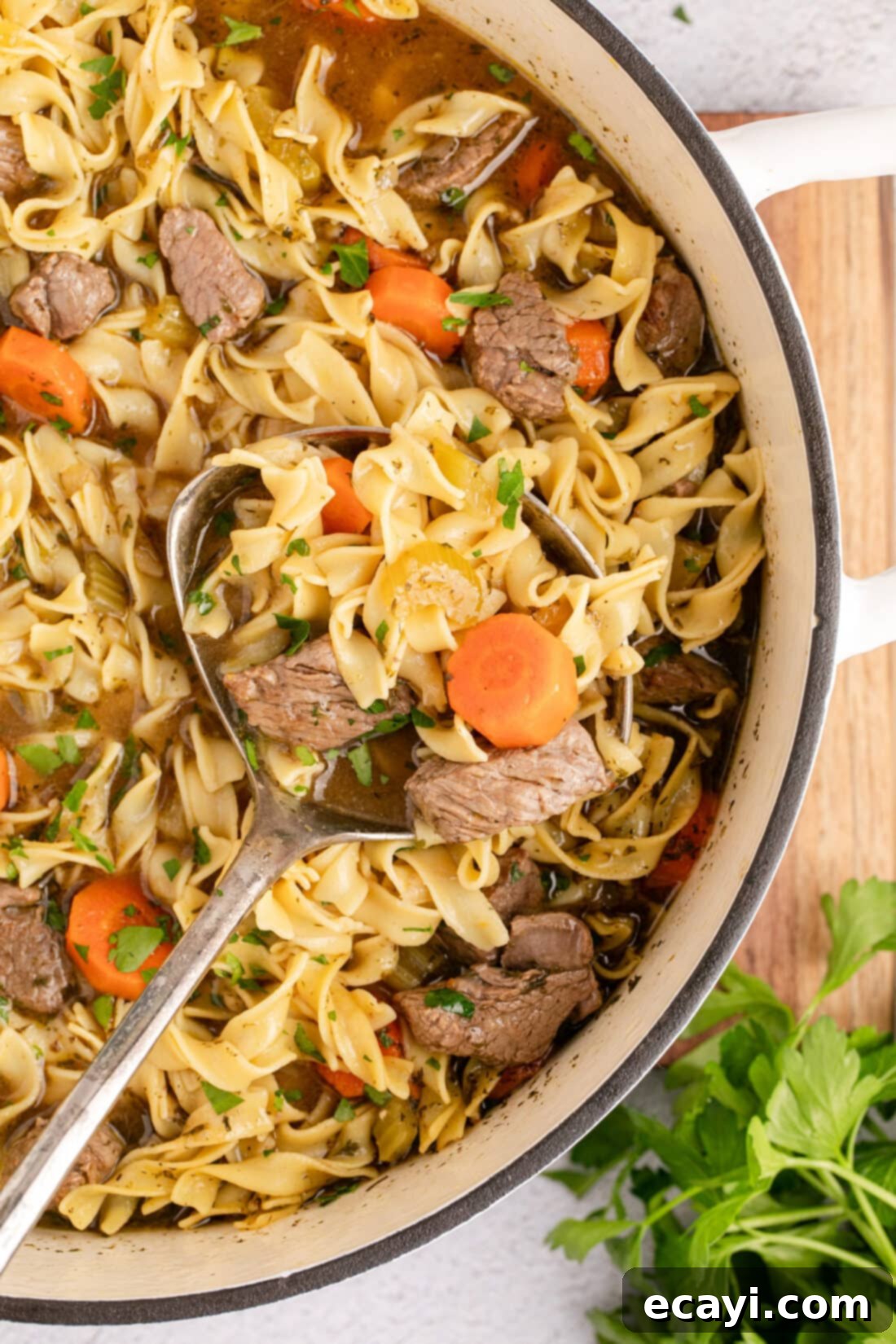
Delightful Serving Suggestions for Your Beef Noodle Soup
This hearty beef noodle soup is a meal in itself, but it can be perfectly complemented with a few simple additions to create a truly memorable dining experience. Garnish your bowls generously with fresh chopped parsley for a bright, herbaceous finish that adds both color and flavor. To fully enjoy every last drop of the rich, savory broth, serve your soup alongside generous chunks of warm, crusty bread or a freshly baked baguette. The bread is perfect for mopping up the delicious liquid. For an even more complete meal, consider a light side salad with a vinaigrette dressing to add a refreshing contrast to the richness of the soup. A sprinkle of grated Parmesan cheese or a dollop of sour cream can also add a creamy texture and extra layer of flavor if desired.
Discover More Comforting Beef Recipes
If you’ve enjoyed this beef noodle soup, you’ll love exploring these other hearty and delicious beef-centric recipes that promise to bring warmth and flavor to your table:
- Classic Beef Stroganoff
- Hearty Beef Carbonnade
- Easy Crockpot Beef Stew
- Wholesome Vegetable Beef Soup
I absolutely adore sharing my passion for baking and cooking, and love bringing my kitchen experiences directly to you! It can be tricky to remember to check back daily for new culinary delights, which is why I’ve made it easy for you. I offer a convenient newsletter that delivers every new recipe directly to your inbox the moment it posts. Simply subscribe today and start receiving your free daily recipes, ensuring you never miss out on a delicious meal idea!
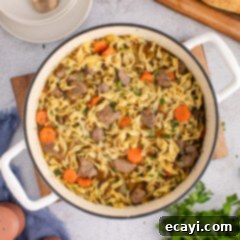
Hearty Beef Noodle Soup
IMPORTANT – There are often Frequently Asked Questions within the blog post that you may find helpful. Simply scroll back up to read them!
Print It
Pin It
Rate It
Save ItSaved!
Ingredients
- 4 Tablespoons olive oil more as needed
- 2 pounds beef stew meat
- 1 large yellow onion chopped
- 4 carrots peeled and chopped
- 3 ribs celery chopped
- 3 cloves garlic minced
- 1 Tablespoon Worcestershire sauce
- 1 Tablespoon sea salt
- 1 teaspoon ground pepper
- 1 teaspoon dried thyme
- 1 teaspoon dried parsley
- 8 cups beef broth
- 2 bay leaves
- 16 ounces egg noodles
Things You’ll Need
-
7 quart Dutch oven
-
Cutting board
-
Chef’s knife
Before You Begin
- You can use any kind of noodle you prefer for this recipe. We like to use thick egg noodles for ours. Old-fashioned extra wide or kluski noodles are excellent here as well, offering a satisfying chewiness.
- For best results, use a low-sodium beef broth to control the saltiness, as the seasonings will also contribute flavor.
- Ensure your beef stew meat is cut into roughly 1-inch cubes for even cooking and tender results.
Instructions
-
Add 2 tablespoons of olive oil to a large Dutch oven over medium heat.
-
Once the oil is hot, add beef to the pot in batches and sear for 1 – 2 minutes per side until well browned. Add more olive oil with each batch as needed to prevent overcrowding and ensure a good sear. Set all the meat aside when browned.
-
If needed, add a little more olive oil (1 tablespoon) to the pot. Add the chopped onion, carrots, and celery and cook on medium heat for about 5 minutes until softened. Stir in the minced garlic and cook for an additional minute until fragrant.
-
Pour in Worcestershire sauce, add salt, ground pepper, dried thyme, dried parsley, and bay leaves. Stir well, then add the beef broth and bring the mixture to a boil. Return the seared beef back into the pot, mix gently, then reduce heat to low. Cover the pot and simmer for 2 hours, or until the beef is tender to your liking.
-
Remove the lid, add egg noodles, and cook for 10 minutes (or according to package directions for desired doneness). If the soup seems too thick or the noodles aren’t fully submerged, add 1 cup of water or more beef broth.
-
Serve warm, garnished with fresh chopped parsley for a burst of color and fresh flavor.
Expert Tips & FAQs
- Storage: Store leftover beef noodle soup in an air-tight container kept in the refrigerator for up to 4 days. Reheat in the microwave or on the stovetop over medium-low heat. Add a splash of broth if it’s too thick.
- Freezing: To freeze, prepare the soup without the egg noodles. Allow to cool completely, then transfer to an air-tight, freezer-safe container, leaving room for expansion. Freeze for up to 3 months. Thaw overnight in the refrigerator. Reheat on the stovetop over medium-low heat and add freshly cooked egg noodles once the soup is hot.
- Vegetable Variations: Feel free to add other vegetables like diced potatoes, mushrooms, or frozen peas/corn (add during the last 5-10 minutes of cooking) for added variety and nutrition.
- Seasoning Adjustments: Taste the soup before serving and adjust salt and pepper as needed. A dash of red wine can also deepen the broth’s flavor.
Nutrition
The recipes on this blog are meticulously tested with a conventional gas oven and gas stovetop to ensure accuracy. It’s important to remember that not all ovens are created equal, and especially as they age, they can cook and bake inconsistently. We highly recommend using an inexpensive oven thermometer to verify that your oven is truly reaching and maintaining the proper temperature specified in the recipe. If you’re using a toaster oven or a countertop oven, please keep in mind that these appliances may not distribute heat uniformly compared to a conventional full-sized oven, and you might need to adjust your cooking or baking times accordingly. For recipes made with specialized appliances like a pressure cooker, air fryer, or slow cooker, a direct link to the specific appliance we use is provided within each respective recipe for your convenience. Finally, for baking recipes where precise measurements are given by weight, please note that substituting with cup measurements may yield different results, and we cannot guarantee success if this method is used instead of weight-based measurements.
